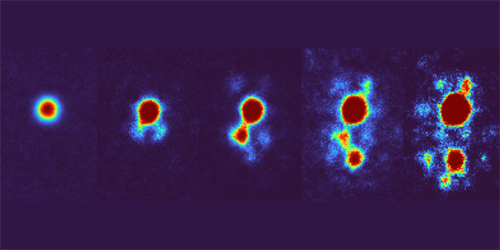A Synthetic Lattice in a Cold Atomic Cloud
One way researchers seek to understand complex phases of matter is by simulating them using lattices of ultracold fermionic atoms. Experimentalists often create such lattices—not physically, in real space, but virtually, in a synthetic space defined by certain properties of the atoms, such as their spin or momenta. While this approach can simulate phenomena that are impossible to reproduce using real-space lattices, the full potential of synthetic-space lattices is yet to be achieved because, so far, they have been limited to 1D or strip-like geometries. Now, using a synthetic-space technique, Paul Lauria at the University of California, San Diego, and his collaborators have realized a 2D triangular lattice [1]. The result could eventually allow the investigation of exotic phenomena involving fermion-fermion interactions.
Researchers typically perform simulations on fermionic synthetic lattices by arranging the atoms in a 1D real-space array and creating an additional synthetic dimension by exploiting the atoms’ spins. Lauria and colleagues demonstrate a twist on this approach that was proposed theoretically a decade ago. In real space, their ensemble of ultracold atoms exhibits a deceptively random arrangement, but they create their triangular lattice entirely in a synthetic space defined by both the momenta and spin of the atoms, which they manipulate using magnetic fields and lasers.
The researchers say that they can simulate a few thousand lattice sites with their experimental setup—comparable to the lattice sizes achieved using conventional real- and synthetic-space techniques. Unlike those approaches, however, their triangular spin-momentum lattice geometry provides a way to simulate 2D topological phases with tunable characteristics—such as synthetic magnetic fields—allowing the investigation of, for example, fractional quantum Hall phases.
–Martin Rodriguez-Vega
Martin Rodriguez-Vega is an Associate Editor for Physical Review Letters.
References
- P. Lauria et al., “Experimental realization of a fermionic spin-momentum lattice,” Phys. Rev. Lett. 128, 245301 (2022).




